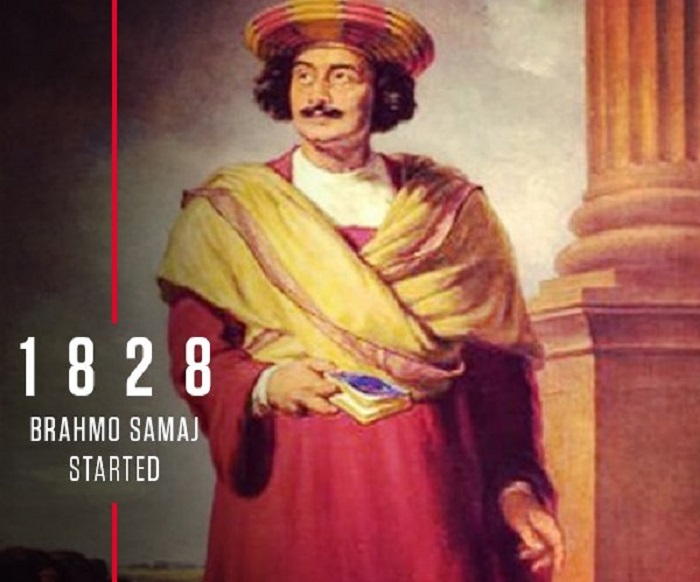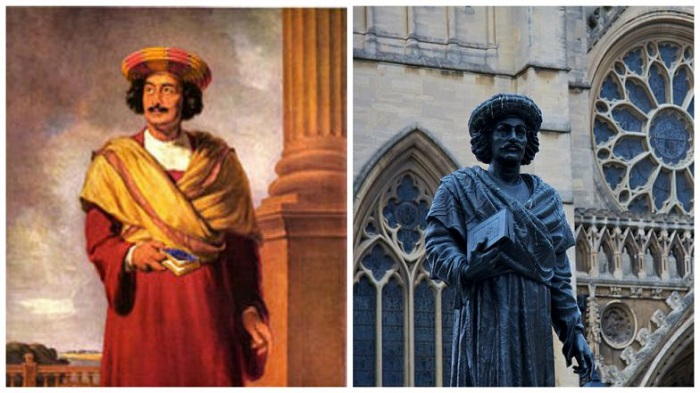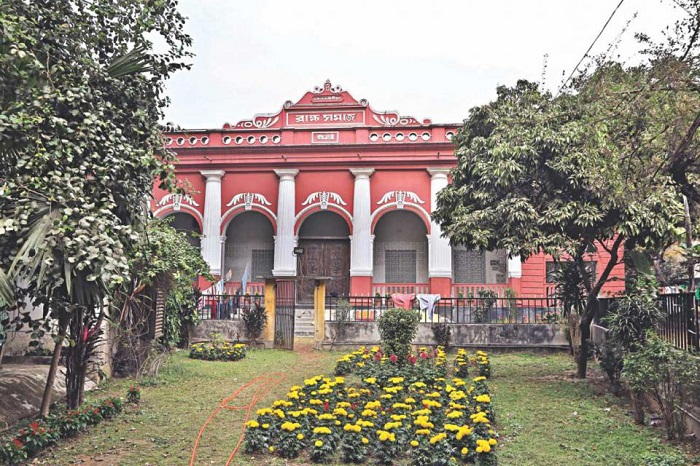Fast Facts
Founder: Raja Ram Mohan Roy
Date of Origin: 20 August 1828
Place of Origin: Calcutta
Theology: Monotheism
Number of Divisions: Two
Brahmo Samaj began as a reformist movement within Hinduism and began the Bengal Renaissance. It was started at Calcutta in 1828 by Raja Ram Mohan Roy and Debendranath Tagore as a reform movement and proved to be one of the most influential religious reform movements in India, and made significant contribution to the making of modern India. The first Brahmo Samaj was founded in 1861 by Pandit Nobin Chandra Roy at Lahore. Attacking the prevailing Brahmanism, it heralded the Bengal Renaissance, which emphasized religious, educational and social reform.

Image Credit : https://www.facebook.com/238044912896496/posts/brahmo-samaj-is-a-hindu/1636999829667657/
Principles
Brahmo Samaj was formed to reform the Hindu society of social and religious eveils, and eradicate practices like the ‘Sati’ and caste system. The movement attacked many traditional Hindu practices that were considered part of one’s daily life. Let’s have a look at the various principles of Brahmo Samaj.
God – Brahmo Samaj advocates the existence of an ‘Infinite Singularity.’ It does not believe in Avatars, reincarnation, or rebirths. It also denounces idol-worship and polytheism. The ‘Infinite Singularity’ is considered limitless, indivisible, imperceivable, and undefinable.
Love – While it urges its followers to treat all creations with respect, Brahmo Samaj never encourages anyone to worship anything or anybody, as only the Singularity or ‘Brahman’ can be worshipped and adored.
Scripture – The followers of Brahmo Samaj, who are called as ‘Brahmo Samajists’ do not believe in any scriptures, prophets and mediators between Brahman and the human soul. Not surprisingly, they don’t believe in the doctrines of Karma as well. However, Brahmo Samajists can believe in Karma and rebirth, depending upon their personal preference.
Liberation – Though Brahmo Samaj believes in the concept of soul and that the soul is immortal and is poised to become a part of Brahman, it does not advocate the concept of salvation or ‘Mukthi.’ Also, it doesn’t believe in the concepts of hell and heaven.
Knowledge – The followers embrace knowledge, truth, and free will. They also consider righteousness as their only way of life. Though the Samaj embraces secular principles, it opposes sectarianism and the act of imposing religious beliefs onto someone.
Superstition – Brahmo Samaj condemns superstition and dogma. In fact, superstitious practices like ‘Sati’ were one of the primary reasons why Brahmo Samaj came into existence. It also validates the supposed insignificance of unscientific rituals, priests, and places of worship like temple, church, and mosque.
Totalitarianism – Brahmo Samaj condemns all forms of totalitarianism. It also rejects irrational and bigotry distinctions like religion, color, creed, caste, and race. These distinctions were considered evil as they often formed the reasons that created rift between human beings.

Image Credit : http://www.insightsonindia.com/2018/05/21/insights-daily-current-affairs-01-may-2018-3/sadharan-brahmo-samaj/
Divisions
In course of time, the Brahmo Samaj got divided two categories – ‘Adi Brahmo Samaj’ and ‘Sadharan Brahmo Samaj.’ Adi Brahmo Samaj was the first development of ‘Brahmoism’ and the first organized movement in the British India. It condemned distinctions between people and laid the foundation for a new and educated secular Indian nation. Started by Raja Ram Mohan Roy, Prasanna Coomar Tagore, and Debendranath Tagore, Adi Brahmo Samaj opposed social and priestly evils of the 18th and 19th centuries.
Sadharan Brahmo Samaj – Schisms in the Brahmo Samaj led to the formation of ‘Sadharan Brahmo Samaj,’ which is a division of Brahmoism. Sadharan Brahmo Samaj was formed in a public meeting, held on May 15, 1878, at the Town Hall of Calcutta. During the time of its foundation, the religious movement was headed by Umesh Chandra Dutta, Sib Nath Shastri, and Ananda Mohan Bose. Though Ananda Mohan Bose was barely 31 years old at the time of the Samaj’s formation, he was made the head of affairs.

Image Credit : https://www.latestly.com/lifestyle/festivals-events/raja-ram-mohan-roy-246th-birthday-facts-about-founder-of-brahmo-samaj-and-social-reformer-who-fought-against-sati-174441.html
Timeline
The Origin – The first official assembly of the ‘Brahmo Sabha,’ which later came to be known as ‘Brahmo Samaj,’ was held on August 20, 1828, at North Calcutta. This was followed by many other meetings that were open to the Brahmins. On January 8, 1830, members of the Kulin clan of Tagore and Roy executed the ‘Trust Deed of Brahmo Sabha.’ On January 23, the premises of Adi Brahmo were inaugurated publicly. In November 1830, Raja Ram Mohan Roy left for England hoping the ‘Trust Deed of Brahmo Sabha’ would be run by his successors.
Scare of Suppression – After Mohan Roy’s departure, Brahmo Sabha was managed by Pandit Ram Chandra Vidyabagish and Dwarkanath Tagore. However, after Ram Mohan Roy’s demise in 1833, the number of participants attending the assembly meetings came down gradually. This was seen as an opportunity to revive idolatry by a sect of Telugu Brahmins. The revival of idolatry was a major blow to the Samaj. The land lords on the other hand were preoccupied in business and trade and hence did not interfere with the affairs of the Brahmo Sabha. This weakened the administration of the Sabha, which was on the verge of dissolution.
Tattvaranjini Sabha – As the Brahmo Sabha started to slump, Debendranath Tagore came up with Tattvaranjini Sabha, which later came to be known as ‘Tattwabodhini Sabha.’ Tattvaranjini Sabha, which was established on October 6, 1839, accumulated more than 500 members over a period of two years. The Bangla translation of ‘Katha Upanishad’ was published by Debendranath Tagore in 1840. According to a modern researcher, the ‘mukhya Upanishad’ from Yajurveda might have influenced Tattvaranjini Sabha as the Sabha’s philosophy was later described as ‘modern middle-class Vedanta.’
The Merger – In 1843, Debendranath Tagore, along with 20 other prominent members of Tattwabodhini Sabha was invited into the ‘Trust of Brahmo Sabha’ by Pt. Vidyabagish. Prominent members like Shridhar Bhattacharya, Brajendranath Tagore, Anandachandra Bhattacharya, Haradev Chattopadhyaya, and Shyamacharan Mukhopadhyaya became part of the group which swore the ‘First Covenant of Brahmoism.’ Even Debendranath Tagore’s brother Girindranath Tagore swore the ‘First Covenant,’ which made other members of the Tattwabodhini Sabha to follow suit. Henceforth, Tattwabodhini Sabha decided to work towards promoting the ideals of Raja Ram Mohan Roy.
Dall’s Arrival – American Unitarian minister Rev. Charles Dall arrived in Calcutta in November 1855. Members of the Sabha, particularly Debendranath Tagore, were not keen about the arrival of Rev. Dall advocated the worship of Christ. Since Brahmo Sabha condemned idol worship or any forms of idolatry, Debendranath Tagore prohibited the entrance of Rev. Charles Dall into the Sabha premises. However, when Debendranath left for Shimla, Rev. Dall formed a counter group called ‘The friends of Rammmohun Roy Society.’ He also succeeded in admitting one of his protégés named Keshub Chandra Sen into the ‘Calcutta Brahmo Sabha’ in 1857. The presence of Keshub Chandra Sen, who happened to be a non-Brahmin, caused several rifts within the Sabha, which forced many important ‘Tattvabodhini Brahmin’ members to leave the Brahmo Sabha publicly.
Debendranath’s Resignation – Upon hearing the tension building up in the Sabha, Debendranath Tagore returned to Calcutta in September 1858 in order to resolve the disputes. However, Debendranath’s indecisiveness did not help the Sabha’s cause. In 1859, the Secretary and one of the most important members of Tattwabodhini, Ishwar Chandra Vidyasagar left Brahmo Sabha citing Debendranath’s vacillation as the reason. This forced Debendranath Tagore to quit the group he had founded. Hence, Debendranath’s son Hemendranath Tagore, who was barely 15 years old, was chosen as Debendranath’s successor to run the Tattwabodhini Sabha.
The Expansion –Hemendranath Tagore made some mature decisions, which helped the Sabha to grow beyond Calcutta. Hemendranath decided to promote Brahmoism to a large extent and hence called upon his friend Pandit Nobin Chandra Roy to spread Brahmoism in North India. The Tattwabodhini Sabha also announced that the faith of the ‘1830 Trust Deed’ would be known henceforth as ‘Adi Dharm.’ The Sabha declared ‘Adi Dharm’ as the ‘uncorrupted faith’ and further added that it will remain separate from the distorted versions of several factions that had sprung up in Calcutta.

Image Credit : https://assetsds.cdnedge.bluemix.net/sites/default/files/styles/very_big_2/public/news/images/dhakas_brahma_samaj.jpg?itok=pBAvXhvE
The Foundation – In 1861, Pandit Nobin Chandra Roy founded the Brahmo Samaj at Lahore. The Samaj included many members, especially Bengalis, from the ‘Lahore Bar Association.’ Subsequently, the members of Brahmo Samaj came up with many branches in Amritsar, Punjab, Rawalpindi, Quetta, etc. Brahmo Samaj eventually became a success, so much so that Swami Vivekananda visited the Sadharan Brahmo Samaj after being influenced by the Brahmo Samaj.
Social and Religious Reforms
The Brahmo Samaj played an important role in building the modern Indian society. It played a crucial role in suppressing caste system, dowry system, and in improving the educational system. It also encouraged women’s empowerment. Keshub Chandra Sen came up with ‘Brahmo Samaj of India’ in 1866, which had overtones of Christianity. Keshub campaigned against child marriages and stressed the importance of women education. However, the marriage of his own underage daughter created controversies, which did not augur well for the ‘Brahmo Samaj of India.’ After the controversy of underage marriage, the ‘Special Marriages Act of 1872’ was passed to set the minimum age of marriage for girls. This act was repealed by ‘Special Marriage Act, 1954,’ which was passed by the government of India. The Samaj was also responsible for various movements of people not directly involved in the Samaj, such as Vidyasagar’s movement that encouraged widow remarriage.


